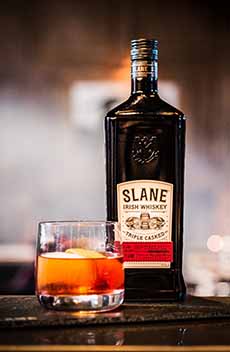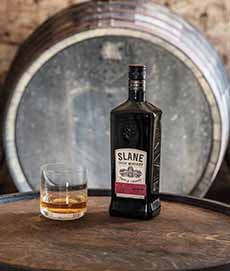|

[1] Slane is a relative newcomer to Irish whiskey. Irish whiskey was one of the earliest distilled drinks in Europe, arising in the 12th century (photos #1 through #4 © Slane Irish Whiskey| Brown-Forman).

[2] Celebrate St. Patrick’s Day with Irish Coffee. Here’s the original recipe and history of the drink.

[3] Slane’s unique triple-casked maturation process creates a bolder Irish whiskey.

[4] Enjoy Slane on the rocks…

[5] …or in a cocktail. Here are recipes for this cocktail and 9 more from prominent mixologists (photo © Thirsty Media).
|
|
St. Patrick’ Day is coming up. Whether you’re a Scotch fan, prefer other whiskies, or no brown goods** at all, St. Patrick’s Day demands that you pay attention to Irish whiskey.
What are the differences between Irish whiskey, Scotch whisky, and whiskies from America, Canada and the rest of the world?
Check out our Whiskey Glossary.
But a brief summary of the differences between Irish and Scotch whiskies:
Irish whiskey is lighter and smoother with a perfumed aroma.
Scotch whisky is has more complex and smoky flavors.
The two countries have different spellings of whiskey/whisky. Here’s why.
While some people prefer one to the other, you can easily enjoy both types (we do!).
WHAT IS IRISH WHISKEY?
Distilled since the 12th century (earlier than Scotch, in the 15th century), Irish whiskey is one of the oldest spirits in the world. Some people think of it as the father of all whiskey.
To be classified as Irish whiskey, it must be:
Distilled and matured on in Ireland.
Produced from a mash of that must contain malted cereals, but can also contain whole grains of other cereals.
With malt dried in a closed kiln away from fire and smoke, distinguishing it from Scotch (which has a smoky flavor).
Bottled at no less than 40% A.B.V.‡ (80 proof).
Aged for a minimum of three years.
Within these criteria, there are 4 distinct types of whiskey produced in Ireland.
TYPES OF IRISH WHISKEY
Irish Pot Still Whiskey is made from a mash of malted barley, unmalted barley and other unmalted cereals, along with water and yeast. It’s distilled in pot stills, then matured for a minimum of three years in casks. The casks were previously used for other spirits such as bourbon or sherry*. The character of the particular casks (i.e., the hint of the previous “occupant”) impacts the flavor of the whiskey.
Irish Malt Whiskey is made from 100% malted barley, water and yeast. The process is the same as Irish Pot Still Whiskey, with the exception of using only malted barley.
Irish Grain Whiskey is made using malted barley and includes whole, unmalted cereals such as maize, wheat or barley. It is then distilled—often triple distilled—using column stills (the difference between pot stills and column stills).
Irish Blended Whiskey is a blend of two or more of the first three whiskey types. A master blender creates the whiskey to express the desired flavors.
Some people have preferences for one style over another; others drink all types. The analogy to Scotch is that some people prefer the style of whisky from a particular production region (Campbeltown, Highlands, Lowlands, Islands, Islay, Speyside); others have broader tastes.
SLANE IRISH WHISKEY
Slane Irish Whiskey is a blended† Irish whiskey with a unique take on aging. It creates a more robust and complex flavor than a traditional blended Irish whiskey.
Slane is owned by Brown-Forman, one of the largest global spirits business.
Slane’s tripled casked method was developed with the Conyngham family in the village of Slane in County Meath—just north of Dublin, in eastern Ireland.
The technique uses a blend of virgin oak, seasoned oak from the Tennessee whiskey barrels of Jack Daniel’s, and oloroso sherry casks from Jerez, the sherry-making city in southwestern Spain.
The distilled whiskey is divided among the three different types of barrels for aging. At the end of maturation, they are blended [source].
The resulting whiskey is bold yet smooth and nuanced:
Virgin oak barrels yield flavors of toasted oak, vanilla and chocolate.
Seasoned oak barrels give flavors of caramel, plum, butterscotch and banana.
Sherry casks add flavors of raisin, spice and tree nuts.
Slane Irish Whiskey is produced using both pot stills and column stills, and is chill filtered.
So for St. Patrick’s Day, for yourself or as a gift, treat yourself to a bottle of Slane’s.
|
________________
*Sherry is a wine that is fortified with a distilled grape spirit. It is then aged in the solera system, and blended before bottling. Here’s more about it.
**Brown goods is an industry term for brown-colored spirits: bourbon, whiskey, etc. White goods are the clear spirits: gin, rum, tequila, vodka, etc.
†A blended Irish whiskey is a mixture of two or more styles. For example, it could be a blend of whiskeies made from malt and grain, pot still and grain, malt and pot still, malt, pot still, and grain, etc.
‡A.B.V., alcohol by volume, is a standard measure of how much alcohol (ethanol) is contained in a given volume of a spirit (or other alcoholic beverage). It is expressed as a percent. The proof of a spirit is two times the A.B.V. For example, 40% A.B.V. equates to 80 proof.
|




